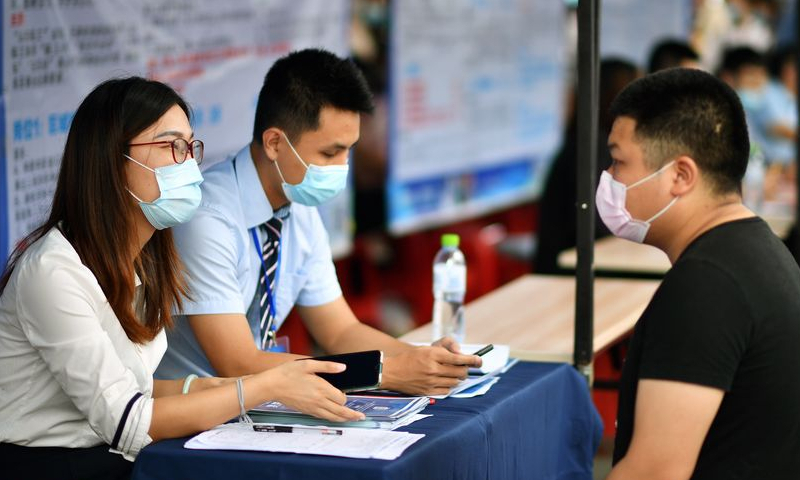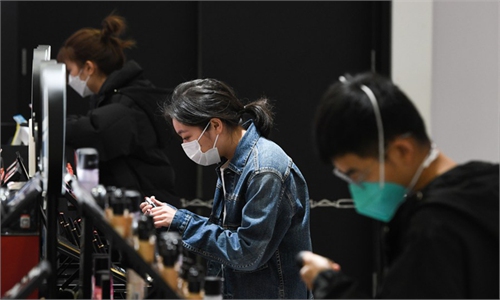Regions across China report passing infection peaks, enter fast track of work resumption
Work resumption on fast track; holiday travel rush adds to hustle and bustle

An employer (left) communicates with a job seeker at a job fair in Haikou, south China's Hainan Province. File Photo: Xinhua
From metropolises like Beijing and Shanghai, to populous provinces including Central China's Henan and Southwest China's Sichuan, regions across the country reported that infection peaks have passed.
The general public has entered a faster track of resuming normal work and production, and on-site job fairs are being held to accelerate the pace. The ongoing Spring Festival travel rush is adding to the hustle and bustle, and experts on Tuesday dispelled concerns that such large-scale migration could lead to severe resurgences.
Henan provincial government revealed during a press briefing on Monday that the COVID-19 infection rate in the province was about 89 percent overall, 89.1 percent in urban areas and 88.9 percent in rural areas, as of January 6.
Henan has passed the epidemic peak and operated in an orderly manner, while the number of new cases is expected to remain at a low level at the end of this month, local officials said.
Health officials in Chongqing said the number of people receiving treatment at fever clinics fell sharply after December 20, with the municipality passing its peak between December 12 and December 23, 2022.
The number of daily infections in Sichuan Province is also declining with more than 80 percent of residents having been infected.
Since the national downgraded management of the COVID-19 response, local health commissions have been monitoring fever clinics at hospitals, community medical centers and pharmacies, and collecting online self-reported data as part of the new statistical approach to evaluate the epidemic situation.
Under such conditions, provinces and regions accelerated their pace of resuming production.
The Beijing authority has released a notification, requiring human resource departments to resume holding on-site job fairs starting from Monday. The notification also urged government assistance to businesses over health protection and personnel recruitment. Tailored job fairs shall be held to meet the needs of companies that are short of labor.
Southwest China's Gansu Province held a job fair on Sunday targeted at veterans, where 102 companies offered 11,367 jobs. A job fair for migrant workers is scheduled on Thursday and similar events for university graduates and other groups will be held in the future.
The Global Times learned from the human resources authority in Hohhot, Inner Mongolia Autonomous Region that it held a job fair for about 20 logistics companies and 226 primary agreements were made.
In the Fengxian district of Shanghai, companies said the Sunday job fair was the most active in the past three years. Tang Liying, a local human resources department staffer, found companies are very specific on their requirements as they are in urgent need of workers to ensure production.
"We also provide subsidies and bonus holidays for people who chose to stay at work during the Spring Festival," Tang said.
Some places are taking similar steps to ensure smooth operation and production during the holidays. For manufacturing, companies are racing against the clock to fill orders postponed by the epidemic, according to media reports.
As the coming holidays will see mass migration, some expressed concerns that places that have already passed their infection peaks could confront a second wave.
But experts believe such a possibility is relatively low. Lu Hongzhou, head of the Third People's Hospital of Shenzhen, told the Global Times on Tuesday that a severe resurgence is unlikely, as the immunity gained through the first wave can last three to six months.
The resumption of production and Spring Festival travel rush could mean transmission, but that will just be a small fluctuation rather than a new peak of infections, Lu said.
Mark Woolhouse, professor of infectious disease epidemiology at the University of Edinburgh, told the Global Times that China's first wave was severe as a result of insufficient immunity. Although future waves are very likely, they should not be as severe as the first.
International experience is that further waves are destined to come, but experts believe accessibility of medicine and richer experience in treatment can help China overcome future challenges.
Vaccination in pace with the epidemic situation, and the timely and extensive usage of anti-virus medicines, are important to overcome the current peak of critical patients and deal with future waves effectively, Lu said.



